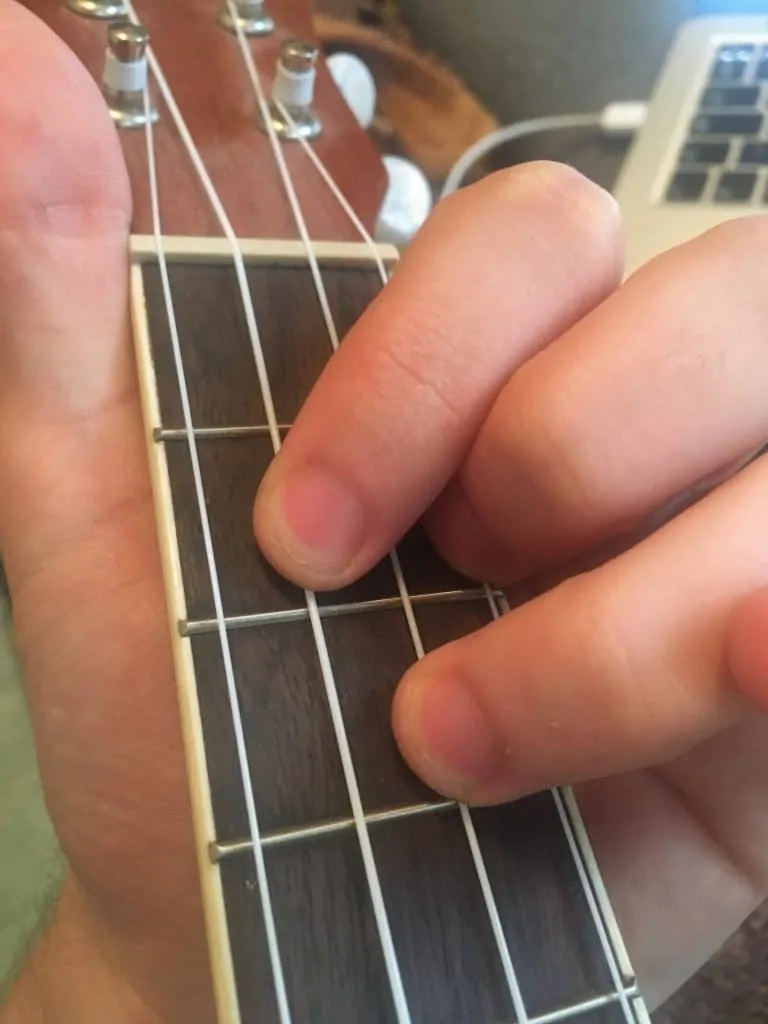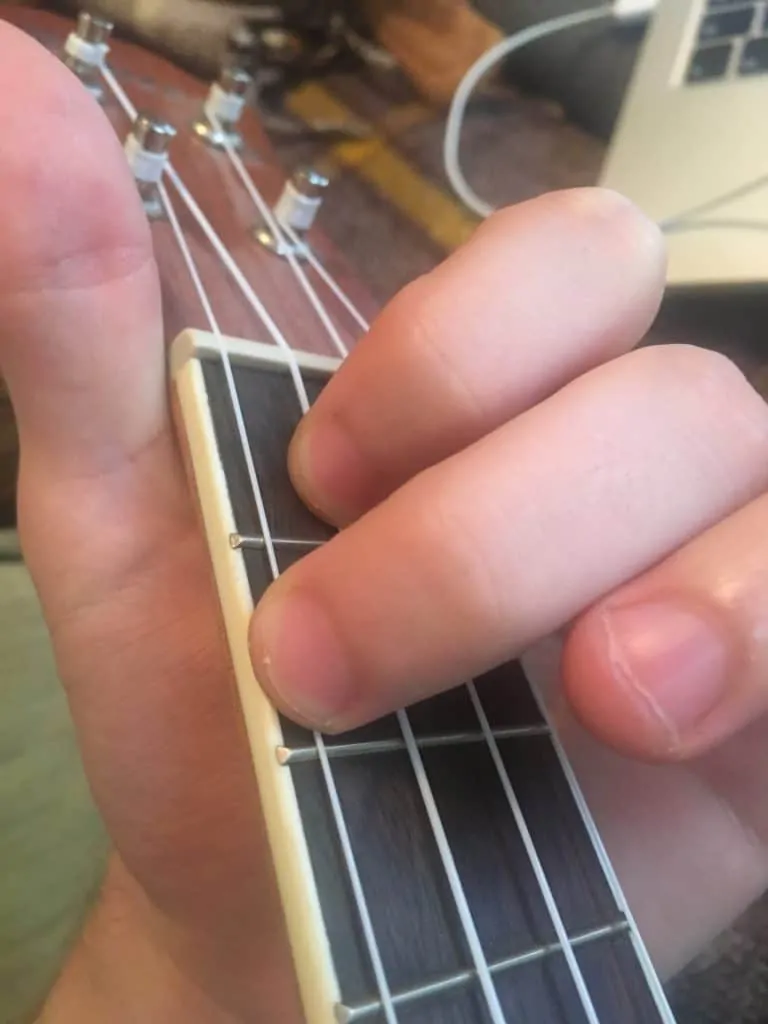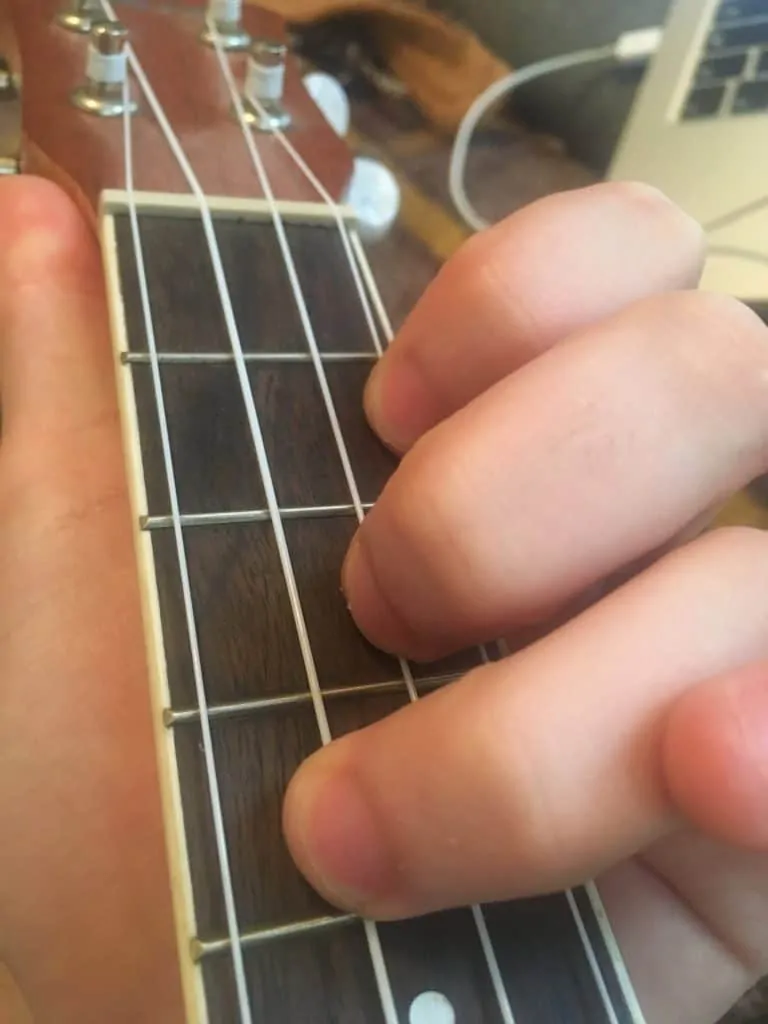Stringed instruments are everywhere, and if you can already play the guitar (if you can’t, use our many guides here at BeginnerGuitarHQ to learn how) then there is a pretty high chance you’ll be able to use what you already know to pick up one of these other instruments.
In this important guide, I’ll help you get a nice head start on learning to play the ukulele.
If you’re looking for a place to start with the ukulele, then look no further…
Contents
What Are The Big Differences Between A Guitar And A Ukulele?
The first thing you’ll probably notice is that they look pretty different. A ukulele is much smaller but generally very affordable, so you might see them quite frequently, though rarely as part of a band. They’ll basically never front a rock band like an electric guitar often will, but for solo versions of songs, a ukulele is a popular choice. This is because they have a typically happy, bouncy sound. However, due to the lack of texture and thickness many ukuleles have, they’re frequently treated with less seriousness than a lot of other instruments. Of course, at the same time, they’re still a stringed instrument with frets and no bow- this means you’ll be able to take your grasp of electric guitar over to the ukulele.
Strings: While a standard guitar has 6 strings, a standard ukulele only has four. If you’ve had a look at our guide to transferring guitar skills to the mandolin, you’ll know that the instrument has quite a complex double string layout. You don’t need to worry about that with a ukulele. The strings on this instrument are thin, flimsy and laid out much like a guitar. While you can fingerpick a ukulele without much trouble, you may need to choose a thinner plectrum, as a thick one that you may play electric guitar could easily overpower the strings. A ukulele also adopts a different tuning than a standard guitar, but we’ll have a look at that in a minute.
Types: While most instruments have a few variations on their designs and types, a ukulele has a few major variants that give a huge range of sounds and feels, and have different uses. Arguably the most common, cheapest and worst is the soprano ukulele. This is a small, high pitched and normally plasticky instrument (though, of course, you can get very high quality professional versions). The frets near the end of the fret board are incredibly close together and border on impossible to play, just like the upper mandolin register.
A tenor ukulele is a more standard, safe bet. You can reach most of the top frets, and the tone of the instrument is much fuller and thicker, leading to a much wider range of playing. This is the version I’d suggest.
A bass ukulele does basically what it says on the tin, providing a ukulele with the ability to go low, with thick strings and a large spectrum to cover the low notes a ukulele normally can’t reproduce. They’re a good gimmick and helpful in ukulele orchestras, but playing a bass ukulele on its own doesn’t have a lot going for it.
Unusual String Placement: Interestingly, the ukulele is built in a strange way, where the highest pitched string is in the position you’d normally expect the lowest string to be. Where an electric guitar is strung in order of pitch, ukuleles throw off this balance and expectation. This means that remembering your 4th string is actually the highest pitch you have makes chords interesting to work out, while your soloing can be really impacted by forgetting about this strange trick.
However, having the high string there can bring you some really cool sounds when you get used to using it to your advantage, having this high pitched string under your thumb when fingerpicking, for example, can provide some really nice chordal arpeggiations.
Getting Yourself A Ukulele
Obviously, as with guitars, there are thousands of ukuleles available to suit all sorts of tones, styles, looks and budgets. Obviously, the ukulele is a much less staple instrument so there aren’t quite as many, but still way too to make it an easy choice. I’ve taken a look at a lot of the ukuleles on offer, and I’ve put together this list of five of the best, based on sound, place in history, look, budget and all-rounder.
Best Sound: Enya EUT-M6 Cutaway Tenor Ukulele. There is something about this ukulele that gives it a rich sound worthy of its price tag. It is built from mahogany, with imported Daddario strings that give it an edge on many other similar instruments. Tenor ukuleles provide the best all round sound in my opinion, so it is fitting that this ukulele is a tenor, with high frets able to be reached for melody and chords.
Most Historically Important: Martin 1T Tenor Ukulele. This particular instrument was created by Martin guitars (a very well-known brand in the acoustic guitar world) so you can trust them to deliver on quality and sound. It is a tribute to one of the most celebrated ukulele players of all time, Israel Kamakawiwo’ole (bit of a mouthful, that one) and aims to provide an incredible sound and look, at an understandably huge price.
Best Looking: Paisen 23-Inch Concert Rosewood Ukulele. If one of the main things that puts you off of the ukulele is that it basically looks like a small, cheap guitar, then this one is certain to change your mind. It basically looks like Bob Marley’s acoustic guitar, but in miniature. A nice bonus is that this is a concert ukulele, meaning it’ll provide you with a full sound that doesn’t have the cheap quality of our next choice.
Most Budget-Friendly: 3rd Avenue STX40PU Ukulele. Now, in this particular scenario, we can overlook the fact that I said above that soprano ukuleles are the worst. They still are. However, to be able to get an instrument for such an incredibly low price is quite impressive, and this particular ukulele makes it arguably the best starter instrument. If you hate it, or can’t get the hang of it, you wasted barely any money at all.
Best All-Rounder: Donner Tenor Ukulele Mahogany. Weirdly, my favourite all round ukulele could easy qualify for the best value category. Again, it is a tenor, with a mahogany body and carbon nylon strings, while the rosewood fretboard allows for a comfortably, non-sticky fretboard experience. This one in particular even comes with a bag, strap, picks, strings and tuner. If I were about to learn the ukulele for the first time, this is probably the one I’d go for, as the sound is going to make your playing satisfying, without coming close to breaking the bank.
Playing With A New Tuning
As discussed above, the ukulele starts you off in a tricky position, with the highest string in the place you expect to find the lowest. This means that a standard ukulele tuning is: G-C-E-A, though remember the G is an octave higher than you’d expect. D-E-B-E is also a common tuning to go for, which mirrors that of the guitar/bass, and copies that of a mandolin. Obviously, you can tune however you like, but the standard started chords below are built on standard tuning.
Some Beginner Chords
When you’re learning any instrument, it’s good to have a basis in a few simple chords so that you have an immediate advantage when learning a song or making up a song. I also find that knowing some chord shapes also brings a bit of theoretical knowledge that will allow you to get used to which fret will create which sound.
C Major: Press your 2nd finger onto the 3rd fret of the 1st string and leave the other frets open to ring out.
D Major: Simply use your 2nd finger to create a barre over the 2nd fret of strings 2, 3 and 4, leaving the 1st string open to ring out.
F Major: Press your 3rd finger onto the 2nd fret of the 4th string, and your 2nd finger onto the 1st fret of the 2nd string. Make sure you aren’t accidentally muting anything in between these positions, as this would create an undesirable effect.
G Major: Press your 2nd finger onto the 2nd fret of the 3rd string, your 3rd finger onto the 2nd fret of the 1st string and your 4th finger onto the 3rd fret of the 2nd string. Leave the lowest (highest pitch) string open. This shape should be easy to get used to as it is essentially the same as a standard D major on guitar.
A Major: Press your 2nd finger onto the 1st fret of the 3rd string and your 3rd finger onto the 2nd fret of the 4th string. Leave the other open to ring out, careful not to accidentally rest a finger on them.
C Minor: Barre the 1st, 2nd and 3rd strings on their 3rd fret using your 2nd finger, leaving the 4th string open.
E Minor: Make a shape not unlike an Fmaj7 on guitar, by pressing your 2nd finger onto the 2nd fret of the 1st string, your 3rd finger onto the 3rd fret of the 2nd string and your 4th finger onto the 4th fret of the 3rd string.
A Minor: Simply put your 2nd finger onto the 2nd fret of the 4th string and allow all of the other strings to ring out above.
Some Inspiration
Israel Kamakawiwo’ole is the starting point of about half of all ukulele players, as they hear him create an incredibly sound armed only with the tiny instrument. His voice does have a lot of impact on the overall impression, but there is no denying that his subtle, quiet ukulele accompaniment doesn’t add to the charm of his version of ‘Somewhere Over The Rainbow’.
I reckon the other half of beginner ukulele players saw this video. Played with extreme precision, unbelievable virtuosity and complete mastery of the instrument, Jake Shimbakuro may well be the best ukulele player of all time, much like Chris Thile is in the world of mandolin. Don’t expect to be able to do things like this straight away, though a more ‘normal’ version of ‘While My Guitar Gently Weeps’ is surprisingly easy to pick up on the ukulele.










